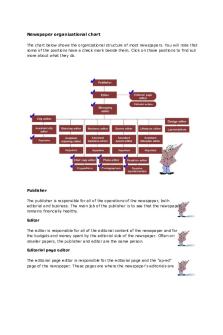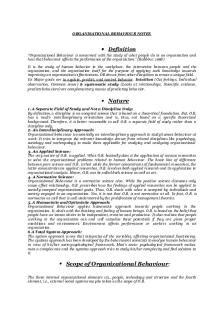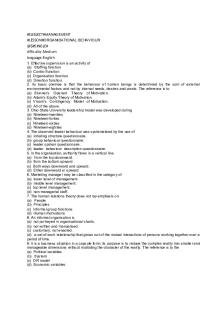Organisational Communication PDF

| Title | Organisational Communication |
|---|---|
| Author | Uri Orlo |
| Course | International Business |
| Institution | University of Canberra |
| Pages | 3 |
| File Size | 35.7 KB |
| File Type | |
| Total Downloads | 56 |
| Total Views | 154 |
Summary
IB Notes...
Description
ORGANISATIONAL COMMUNICATION: STRUCTURE AND STRATEGY Organisational stakeholders Company Trade Unions Media Customers Shareholders Employees Suppliers Creditors Government communication (part of strategic mgmt) = pivatol for organisation poor communication = poor organisation -> can lead to falling share price; damage reputation LEADER = COMMUNICATOR -> poor communicators aren‘t long in leadeship positions good communication: improves job satisfaction / productivity, reduces turnover, costumer loyalty bad communication: drives costumers away, lowers staff moral, prevents internal information transfer dialectical (mutually constitutive) relationship between communication & organisation (shaping one another) Each group is affected by organisation‘s activites differently. OVERLAPING groups possible! Each has there own requirements / interest in the Organisation. External / Internal stakeholders Stakeholder communication plan: who is told what, how and when
Integrated corporate communication making sure that ALL messages transmitted within / outside the organisation ARE COHERENT content should never clash! otherwise the credibility / trustworthiness will suffer! Box 1.F Task: Identifying errors in integrated corporate communication (see p. 12)
CONTENT do all manifestations of communication convey the SAME message, or at least COMPATIBLE ones?
FORM Is this message presented in a CONSISTENT form, stylistically as well as layout, typography, visuals and colours? TIME Are different messages timed so as to reinforce each other? Have various stake-holders been informed at the appropriate time?
3 dimensions of Integration Box 1.G Example: Aligning communication with strategy „ Corporations have multiple constituents, and their communications must be responsive to all of them. ‚The job of a senior manager is to determine which elements of the overall strategy you want to communicate to each constituency‘ ,says CEO Kevin Rollins. Whether a company is developing a coherent identity for itself through advertising, is discussing with employees the reasons for a merger and subsequent workforce reductions or is explaining to shareholders why it didn‘t meet fourth-quarter projections, employing a coherent communication strategy is critical. ‚We break messages into pieces and try to give the right piece to the right audience.‘ says Rollins „to achieve full strategic impact, all Communications to all constituencies through all channels must be customized to a given objective, yet consistent both with one another and the corporate strategy“ Brand tone of voice „to make sure that values, personality, or essence of the brand is uppermost in every situtation in which people come into contact with the brand‘s language (=touchpoints).“ i.e.brochures, billboards, websites BUT ALSO text on bills! Controlling communication
• fairly large-scale policy-issues such as the choice of English as corporate language in multinational company • decisions about which communication media are appropriate for each constituent = picking communication channels • crisis communication plans • complaints management systems (lutzky, forthcoming) • scripts employees have to follow • specifying pronouns used to address customers (e.g. Du / Sie) Why communication is often underrated: • Education: Communication often seen as „soft skills“ = fuzzy and easy • Management academia: often researched „on the side“ • Management degree programmes: Degrees in Communication rare • Business schools: Chairs in Business Communication are rare POINT • Communication is easy because we learn how to speak and use it every day • Language is less important than action • Words are less objective than statistics • difficult to measure the effect of communication COUNTERPOINT • Communication requires expertise • Language IS action - we do things with words! • Figures are also biased. Sometimes text describe complex situations better • Communication does have an impact on the success or failure of organisations FOUR MISCONCEPTIONS ABOUT COMMUNICATION
Communication = exchange of facts, ideas and feelings „One cannot not communicate.“ (watzlawick, Bavelas, Jackson) even the choice to not answer = communication!...
Similar Free PDFs

Organisational Communication
- 3 Pages

Organisational structure
- 3 Pages

Organisational feasibility
- 2 Pages

Organisational Behaviour
- 26 Pages

Organisational behaviour
- 1 Pages

Organisational Rights
- 4 Pages

Lec+2-+Organisational+Behaviour
- 22 Pages

Organisational Behaviour Notes
- 9 Pages

Organisational Behaviour MCQ
- 121 Pages

Assignment 3 Organisational Analysis
- 10 Pages
Popular Institutions
- Tinajero National High School - Annex
- Politeknik Caltex Riau
- Yokohama City University
- SGT University
- University of Al-Qadisiyah
- Divine Word College of Vigan
- Techniek College Rotterdam
- Universidade de Santiago
- Universiti Teknologi MARA Cawangan Johor Kampus Pasir Gudang
- Poltekkes Kemenkes Yogyakarta
- Baguio City National High School
- Colegio san marcos
- preparatoria uno
- Centro de Bachillerato Tecnológico Industrial y de Servicios No. 107
- Dalian Maritime University
- Quang Trung Secondary School
- Colegio Tecnológico en Informática
- Corporación Regional de Educación Superior
- Grupo CEDVA
- Dar Al Uloom University
- Centro de Estudios Preuniversitarios de la Universidad Nacional de Ingeniería
- 上智大学
- Aakash International School, Nuna Majara
- San Felipe Neri Catholic School
- Kang Chiao International School - New Taipei City
- Misamis Occidental National High School
- Institución Educativa Escuela Normal Juan Ladrilleros
- Kolehiyo ng Pantukan
- Batanes State College
- Instituto Continental
- Sekolah Menengah Kejuruan Kesehatan Kaltara (Tarakan)
- Colegio de La Inmaculada Concepcion - Cebu





